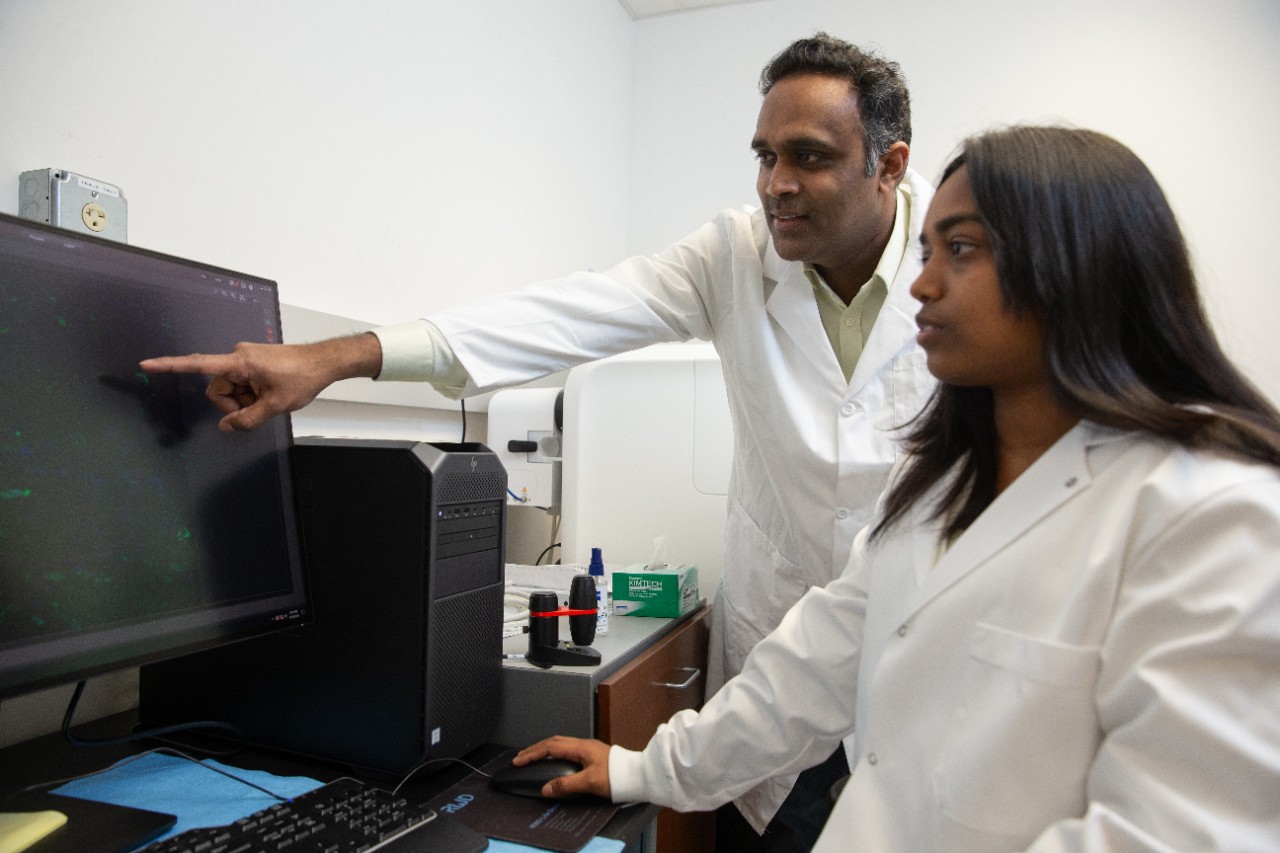
UC study identifies molecule that could improve asthma treatments
Researcher cites personal experience for passion for the project
Researchers are passionate about their fields of study for a variety of reasons. For Satish Madala, his focus on asthma is deeply personal.
“This is my ‘close to heart’ project because I came to this research area mainly because of my childhood asthma,” says Madala, PhD, of the Division of Pulmonary, Critical Care, and Sleep Medicine at the University of Cincinnati College of Medicine. “When I would ride my bike on the streets with my friends and I had diesel exhaust exposure, I had an asthma attack. I always wondered why my friends were fine and I was not. ‘What’s wrong with my lungs?’ I wondered.”

Satish Madala, PhD, in the Department of Pulmonary, Critical Care and Sleep Medicine at the UC College of Medicine/Photo/Andrew Higley/UC Marketing + Brand
Asthma is a common chronic airway inflammatory disease that affects more than 300 million people worldwide. Madala headed up a team of researchers at UC and Cincinnati Children’s on a study that identified a new molecule that plays a role in asthma and could be targeted for treatment in the future.
The research was published in the journal Nature Communications.
“The study has implications beyond asthma because it is looking at what happens in a smooth muscle cell which is present around our airways, blood vessels and other organs,” Madala says. “Every tube structure that we have in our body is built up with the smooth muscles.”
Madala says this paper used asthma as a disease model where significantly increased levels of the studied molecule were found in smooth muscle cells of the airways in animal models with allergic asthma.
Further investigation revealed that common asthma-associated cytokines could directly trigger this increase in both human and animal airway smooth muscle cells. These cells play a crucial role in airway constriction or the narrowing of the airways. Intriguingly, blocking that one specific molecule through genetic manipulation in animals led to a significant reduction in the narrowing of airways without affecting other key asthma features like inflammation and mucus production. This suggests that targeting that molecule could offer a novel approach to treating airway obstruction without impacting other aspects of the disease.
“Our findings identify a distinct pathway contributing to airway hyperresponsiveness, independent of classic inflammatory processes,” explains Madala, senior author of the study. “At this point, there is a lot more research that needs to be done to see how this new molecule is performing its function in increasing the calcium elevation in the smooth muscle cells making those cells contract more aggressively. If that interaction or process can be interrupted, then probably we can reduce how violently these smooth muscle cells react in these airways. If this is the one that can be manipulated and mitigated to cause that increase, then it can provide a great health care outcome.”
This discovery opens exciting possibilities for developing more effective and specific therapies for improving lung function, a major challenge for many asthma patients.
Satish Madala, PhD
"It’s important to note that this is early-stage research, and further studies are needed to confirm these findings in humans and explore the safety and efficacy of targeting [the molecule] for asthma treatment,” cautions Madala. “However, this discovery opens exciting possibilities for developing more effective and specific therapies for improving lung function, a major challenge for many asthma patients.”
For graduate student and study co-author, Santhoshi Akkenapally, this project has sharpened her passion for research, particularly in this area.
“Being part of this research team has been an incredible learning experience,” says Akkenepally, a student researcher who contributed to the study. “Seeing firsthand how basic science research can unlock the secrets of complex diseases like asthma is truly inspiring. I'm excited to see where this discovery leads and the potential impact it could have on millions of people living with asthma.”
She says this study amplified her dreams and the quest to lead scientific programs and conquer diseases like asthma.
“I’ll try my level best,” she says.
Lead photo of Madala and Akkenapally/Andrew Higley/UC Marketing + Brand
Next Lives Here
The University of Cincinnati is classified as a Research 1 institution by the Carnegie Commission and is ranked in the National Science Foundation's Top-35 public research universities. UC's graduate students and faculty investigate problems and innovate solutions with real-world impact. Next Lives Here.
Related Stories
News Cincinnati loved in 2025
January 2, 2026
The story of prohibition bootlegger George Remus was among WLWT's favorite segments in 2025. UC Law Professor Christopher Bryant spoke with journalist Lindsay Stone about Remus using a temporary insanity defense during a murder trial.
Study finds police officers face higher long-term health risks
January 2, 2026
J.C. Barnes, a University of Cincinnati professor, is interviewed by Spectrum News about new research showing that the physical and psychological demands of law enforcement can contribute to earlier deaths.
UC College of Nursing Professor honored with AANA education excellence award
December 23, 2025
Susan Newell, assistant professor in the UC College of Nursing, is being recognized by the American Association of Nurse Anesthesiology (AANA) as one of three top educational administrators and instructors. She will receive the Clinical Instructor of the Year Award during AANA's top educator event 2026 EDGE Conference, February 4-7 in Louisville, Kentucky.
